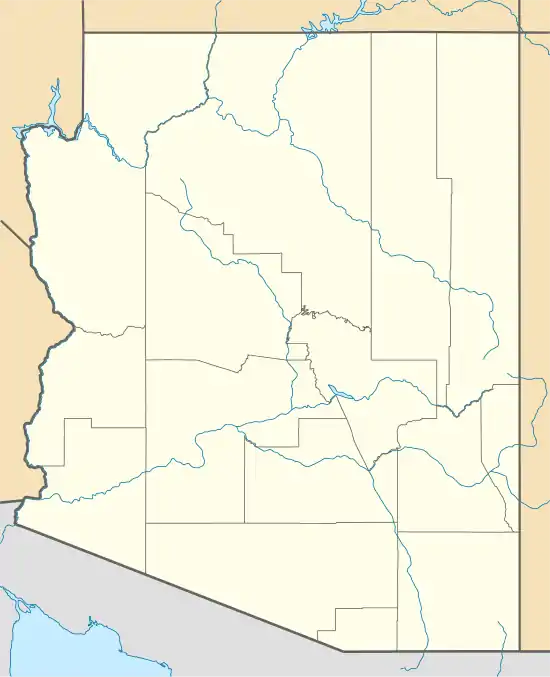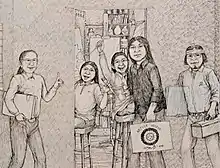Hopi Cultural Center
The Hopi Cultural Center is a place in the Hopi Reservation on Second Mesa, Arizona where visitors can learn about the culture, history and art of the Hopi people. It also provides lodging and a restaurant that serves Hopi cuisine. A museum is also part of the cultural center. Hopi ceremonies also take place at the center, although many of these are not open to the public.
| The Hopi Cultural Center | |
|---|---|
 | |
 Location in Arizona | |
| General information | |
| Address | AZ-264, Second Mesa, Arizona 86043 |
| Coordinates | 35.79323°N 110.645232°W |
| Opened | 1971 |
| Website | |
| https://hopiculturalcenter.com | |
About
The Hopi Cultural Center is located in Second Mesa, Arizona.[1] The center has lodging, a gift shop selling arts and crafts made by local Hopi artisans, a restaurant featuring Hopi cuisine and a museum.[1]
The motel is based on traditional Hopi architecture and features a "stucco maze with outdoor walkways and balconies outside second-floor rooms."[2] Currently, there are 33 guest rooms and the motel includes meeting rooms for conferences.[3]
Cultural programs are hosted at the center. Some of these include "hands-on" activities, such as Planting Day, where participants learn about Hopi farming.[4] The Hopi Cultural Center also hosts Hopi snake dances, although these are closed to the public.[1] Some Katsina dances are open to the public, but these do not allow any type of visual or audio recording of the ceremonies.[3]
Museum
The Hopi Cultural Center Museum contains objects of Hopi art and craftsmanship, including kachinas, weaving and pottery.[5] Historic artifacts such as documents and photographs are also part of the collection.[5]
The museum originally opened with objects on loan from the Museum of Northern Arizona.[5]
Notable individuals who have shown work or have items in the collection include Michael Kabotie,[6] and Priscilla Namingha.[7]
History
Hopi artist, Fred Kobotie, wanted to bring Hopi culture and art back to the Hopi Reservation.[8] In 1965, he began to plan the cultural center and, along with several sponsors, set up the Hopi Cultural Center, Inc. as a nonprofit entity.[8] Together, the Hopi tribe applied to the Economic Development Administration (EDA) for financing in 1968.[9] The new building was dedicated on June 26, 1971.[10] Governor Jack Williams spoke at the dedication.[11]

In 1973 Hopi artists Michael Kabotie, Terrance Talasawaima, and Neil David Sr. formed the Artist Hopid. Joined by Delbridge Honanie and Milland Lomakema they opened a shop and studio in the Hopi Cultural Center mall. The group’s objectives included: researching and documenting Hopi history through visual arts for posterity and educating Hopi and non-Hopi about the cultural values of the Hopi Their work was well received and as a result the Artist Hopid were given a grant from the National Endowment for the Arts and the Arizona Commission on the Arts and Humanities.[12]
The museum of the cultural center received a $10,000 grant from the Weatherhead Foundation for display cabinets.[13] The cabinets were based on a similar design used at the Museum of Northern Arizona.[14] The first curator was Terrance Talaswaima.[5] Anna Silas was the director of the museum in the 1990s and worked as curator for nearly forty years.[15][16]
The restaurant was remodeled in the early 1980s.[17]
References
- Bitler, Teresa; Levin, Mara; Riley, Elise (2018). Kelly, Margaret; Leto, Denise; Stallings, Douglas (eds.). Fodor's Arizona & The Grand Canyon. Fodor's Travel. ISBN 978-1-64097-027-4.
- Trimble, Stephen (2006-05-21). "High REZolution". The Fresno Bee. pp. K3. Retrieved 2020-08-07 – via Newspapers.com. and "Rez: Residents Reach Out to Visitors". The Fresno Bee. 2006-05-21. pp. K5. Retrieved 2020-08-07 – via Newspapers.com.
- "Hopi Cultural Center". Visit Arizona. Retrieved 2020-08-08.
- "Hopi Cultural Center Hosts Planting Day". Arizona Daily Sun. 2013-04-30. p. 8. Retrieved 2020-08-07 – via Newspapers.com.
- Schroeder, John (1974-03-30). "Hopi Museum Holds Heritage". Arizona Republic. p. 20. Retrieved 2020-08-08 – via Newspapers.com.
- Bruner, Betsey (2009-11-02). "Michael Kabotie - Leaving a vibrant legacy for the world". Webmaster's Blog - Native American Resources. Retrieved 2020-08-08.
- "Priscilla Namingha Nampeyo". In the Eyes of the Pot. Retrieved 2020-08-06.
- Dedera, Don (1965-03-28). "Soon There May Be a Place to Pause In Long, Lonely Trip Across Hopiland". Arizona Republic. p. 25. Retrieved 2020-08-07 – via Newspapers.com.
- Cooper, Tom C. (1968-04-07). "Hopis, Full of Industry, To Have a Go at Tourism". Arizona Republic. p. 16. Retrieved 2020-08-07 – via Newspapers.com.
- "New Hopi Cultural Center to be Dedicated Saturday". Arizona Daily Sun. 1971-06-21. p. 1. Retrieved 2020-08-07 – via Newspapers.com.
- "Williams Praises Drought Planning By Hopi Tribe". Arizona Daily Star. 1971-06-27. p. 7. Retrieved 2020-08-07 – via Newspapers.com.
- Pecina, Ron and Pecina, Bob; Art by Neil David. Neil David’s Hopi World. Pp104-105. Schiffer Publishing Ltd., 2011. ISBN 978-0-7643-3808-3
- "Hopi Center Granted $10,000 for Cabinets". Arizona Republic. 1971-08-13. p. 14. Retrieved 2020-08-07 – via Newspapers.com.
- "New Yorkers Visiting Hopi Cultural Center". Arizona Daily Sun. 1971-08-26. p. 6. Retrieved 2020-08-07 – via Newspapers.com.
- Cart, Julie (1998-08-25). "Kachina-Doll Feud Divides Two Tribes". Los Angeles Times. Retrieved 2020-08-08.
- "Kachinas in the Classroom". Faust Gallery. Retrieved 2020-08-08.
- Borcorver, Alfred (1984-06-24). "Indians Put Welcome Blanket Out at Hopi Cultural Center". Chicago Tribune. p. 233. Retrieved 2020-08-07 – via Newspapers.com.